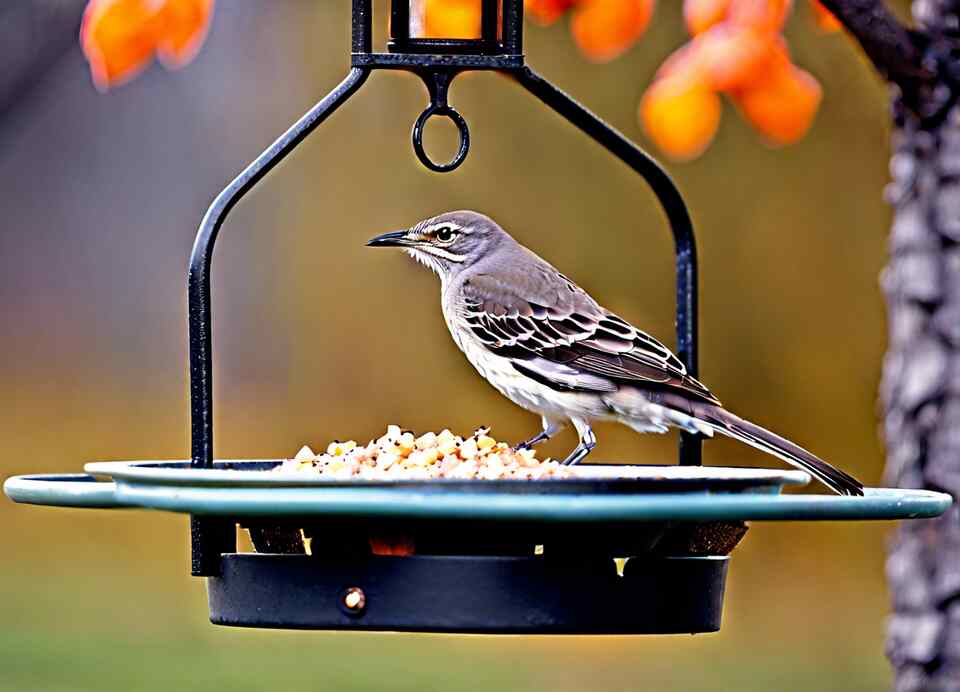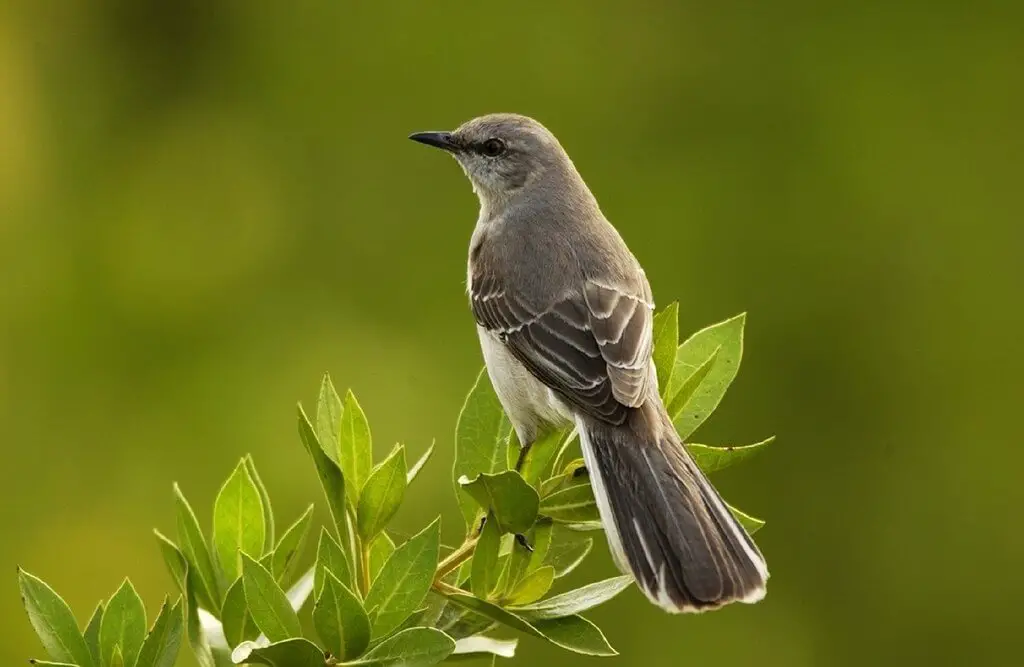
Hey there! Ever wanted more birds in our backyard? Today, let’s talk about making Mockingbirds feel at home. They’re like our backyard buddies! I’ve got some easy tricks to make them cozy. So, grab a seat, and let’s make our yard the best bird hangout!
Table of Contents
Key Takeaways:
- Provide a diverse range of food sources, including fruits, berries, seeds, suet, and mealworms.
- Create a habitat with dense shrubbery and trees for nesting and shelter.
- Offer a water source, such as a birdbath or shallow dish.
- Install strategically placed perches, such as birdhouses or elevated branches, for security and surveillance.
- Avoid the use of pesticides in your yard to maintain a healthy environment for Mockingbirds and their prey.

Effective Strategies for Attracting Mockingbirds to Your Yard
Proven Strategies for Success
Mockingbirds are captivating birds known for their impressive vocal abilities and lively personalities. If you’re looking to bring these dynamic creatures to your backyard, there are several effective strategies you can employ. By creating a welcoming environment and catering to their specific needs, you can increase the chances of attracting mockingbirds and enjoying their presence in your outdoor space.
Provide a Diverse Food Source
Mockingbirds are opportunistic foragers, feeding on a variety of insects, berries, and other small foods. To attract them, consider planting a diverse array of native plants that provide a year-round food supply. This could include berry-producing shrubs, fruit-bearing trees, and flowering plants that attract insects. Additionally, you can attract them by offering fruits like berries, chopped apples, or raisins on a platform feeder or shallow tray placed close to the ground. Additionally, a mix of seeds, suet, and mealworms can further supplement their dietary needs.
Offer Water and Bathing Opportunities
Mockingbirds, like many birds, require a reliable source of water for drinking and bathing. Install a birdbath or shallow dish filled with clean, fresh water. Positioning it in a visible yet sheltered area of your yard will make it more appealing to the birds. Regularly maintaining and cleaning the water source will ensure it remains inviting and free of debris.
Create Diverse Nesting Habitats
Mockingbirds prefer to nest in dense, well-concealed shrubs or low-growing trees. Planting a variety of native bushes, hedges, and small trees can provide the necessary cover and nesting sites. Avoid pruning these plants excessively, as this can disrupt the birds’ natural nesting behaviors.
Minimize Disturbances and Provide Perches
Mockingbirds are known to be territorial and can become wary of areas with high human activity or the presence of predators. Maintain a peaceful, low-disturbance environment by keeping pets indoors, limiting loud noises, and avoiding excessive yard work near potential nesting sites. Additionally, installing strategically placed perches, such as birdhouses or elevated branches, will give the mockingbirds a sense of security and a vantage point to survey their surroundings.
Incorporate Native Plants and Vegetation
Mockingbirds thrive in environments that mimic their natural habitats. Planting native trees, shrubs, and grasses will not only provide food and nesting resources but also create a familiar and inviting landscape. Native plants are often better adapted to local conditions and require less maintenance, making them an eco-friendly choice for attracting mockingbirds.
Practice Patience and Observation
Attracting mockingbirds to your yard may not happen overnight. These birds can be cautious and take time to become comfortable in a new environment. Observe your yard closely and make gradual changes to accommodate their needs. Be patient and persistent, as your efforts will be rewarded with the captivating presence of these talented songbirds.
Remember, the key to successfully attracting mockingbirds is to create a holistic, inviting environment that caters to their diverse needs. By incorporating these strategies, you can transform your yard into a haven for these remarkable birds and enjoy their lively serenades for years to come.
The Benefits of Hosting Mockingbirds in Your Outdoor Space
Attracting Melodious Guests
Mockingbirds are a delightful addition to any outdoor space, bringing a captivating melody and engaging presence. These feathered friends not only provide endless entertainment but also offer a range of benefits that can enhance your yard or garden. From their role in pest control to their contribution to a balanced ecosystem, hosting mockingbirds can be a rewarding and fulfilling experience.
The Serenade of Nature
Mockingbirds are renowned for their impressive vocal abilities, capable of mimicking a vast array of sounds. From the call of other birds to the chime of a nearby bell, these talented vocalists will fill your outdoor space with a mesmerizing symphony. Their repeated songs and improvisational performances can create a serene and tranquil atmosphere, allowing you to immerse yourself in the natural world.
Pest Management Allies
Mockingbirds are not only delightful to listen to but also serve as invaluable allies in pest management. These birds are voracious insect eaters, consuming a wide variety of pests that can harm your plants and gardens. From aphids and beetles to caterpillars and larvae, mockingbirds play a crucial role in maintaining a balanced and healthy ecosystem in your outdoor space.
Ecological Balance and Biodiversity
By attracting mockingbirds to your yard, you’re not only enhancing your own enjoyment but also contributing to the overall ecological balance of your local environment. Mockingbirds are integral parts of the food chain, serving as both predators and prey. Their presence helps to support a diverse array of other wildlife, from the insects they consume to the predators that may hunt them.
Year-Round Companionship
Unlike many migratory bird species, mockingbirds are residents throughout the year, providing a constant source of entertainment and joy. Whether it’s their melodious serenades in the spring, their playful antics in the summer, or their resilience in the winter, these birds will be a reliable and engaging presence in your outdoor space.
Symbiotic Relationships
Hosting mockingbirds can also foster symbiotic relationships with other plant and animal species in your yard. For example, mockingbirds may help to disperse the seeds of various fruiting plants, contributing to the growth and diversity of your garden. Additionally, their presence can attract other beneficial species, such as insect-eating birds or pollinators, further enhancing the overall health and vibrancy of your outdoor space.
Fostering a Connection with Nature
Watching and listening to mockingbirds can be a deeply rewarding experience, fostering a stronger connection with the natural world. By inviting these charismatic birds into your outdoor space, you’ll have the opportunity to observe their behaviors, appreciate their unique qualities, and gain a deeper understanding of the intricate web of life that surrounds us.
Creating a Welcoming Environment
Attracting mockingbirds to your yard or garden is not only beneficial for the birds but also for you, the homeowner. By providing a safe and nurturing environment for these feathered friends, you’ll be creating a space that is inviting, serene, and rich in natural wonder. This can positively impact your overall well-being, reducing stress and promoting a sense of tranquility and connection with the great outdoors.
Hosting mockingbirds in your outdoor space offers a multitude of benefits, from their captivating serenades to their role in maintaining a healthy ecosystem. By welcoming these remarkable birds into your yard, you’ll not only enhance your own enjoyment and connection with nature but also contribute to the overall well-being of your local environment.
Conclusion
Attracting mockingbirds to your yard can be a rewarding experience that not only adds visual interest and melodic charm but also provides meaningful environmental benefits. By implementing effective strategies such as offering diverse food sources, providing suitable nesting areas, and creating a bird-friendly landscape, you can invite these captivating songbirds to take up residence in your outdoor space.
One of the primary reasons to welcome mockingbirds is their remarkable ability to control insect populations. These versatile birds are voracious predators of various pests, including caterpillars, beetles, and grasshoppers, making them valuable allies in maintaining a healthy, balanced ecosystem. As they forage throughout your yard, mockingbirds help to keep pest populations in check, reducing the need for potentially harmful pesticides and contributing to a more sustainable, natural approach to gardening and landscaping.
In addition to their pest control capabilities, mockingbirds also play a crucial role in the pollination of numerous plant species. As they flit from flower to flower, these birds inadvertently transfer pollen, facilitating the reproductive process and contributing to the overall vitality of your garden. This symbiotic relationship between mockingbirds and the plant life in your yard can enhance the diversity and productivity of your outdoor space, creating a thriving, biodiverse environment.
Moreover, the presence of mockingbirds can add an enchanting element to your backyard experience. Their distinctive and varied vocalizations, which can imitate the calls of dozens of other bird species, create a captivating auditory backdrop that can be enjoyed from the comfort of your own home. The sight of these agile, gray-feathered birds effortlessly darting from perch to perch, or engaging in their spirited territorial displays, can also provide endless hours of birdwatching delight.
By fostering a mockingbird-friendly habitat, you are not only contributing to the overall health and vibrancy of your local ecosystem but also cultivating a deeper connection with the natural world. Watching these resilient and adaptable birds thrive in your yard can instill a sense of wonder and appreciation for the beauty and complexity of the avian world, inspiring you to further explore and protect the diverse array of bird species that share our shared spaces.
The decision to attract mockingbirds to your yard is a multifaceted endeavor that offers a wealth of benefits, from practical pest management to the enchanting auditory and visual experiences they provide. By implementing the strategies outlined in this article, you can create a welcoming and nurturing environment that will allow these remarkable birds to thrive and enrich your outdoor space for years to come.


